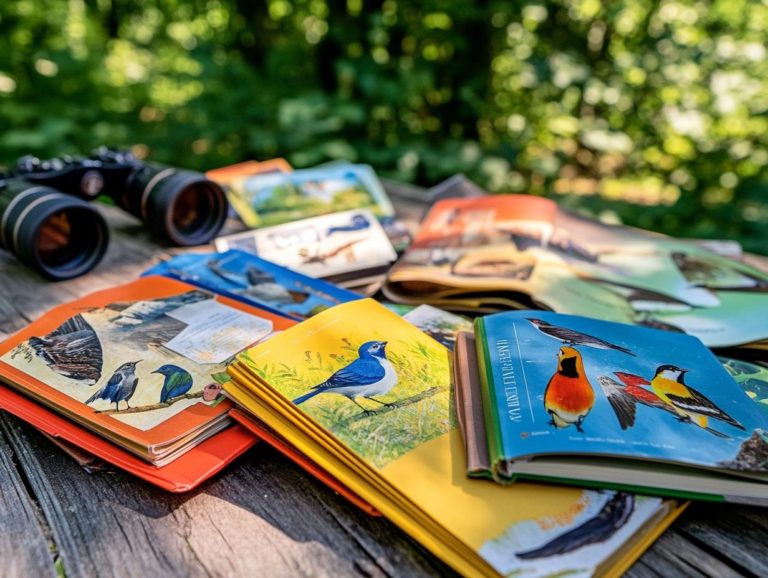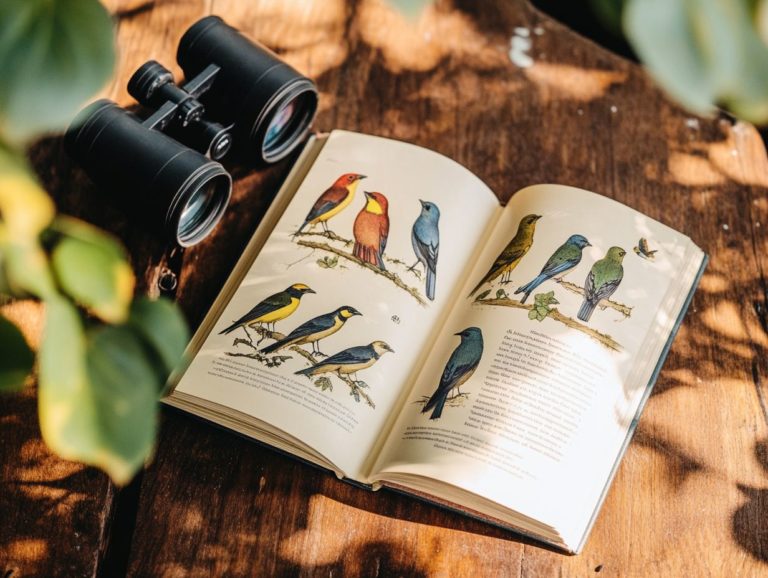How to Choose the Right Bird Field Guide
Birdwatching can be an incredibly rewarding hobby, but having the right tools at your disposal can truly elevate your experience.
A quality bird field guide isn t merely a resource; it s your trusted companion in identifying a myriad of species and understanding their unique behaviors.
This article delves into the essential role bird field guides play, comparing printed and digital formats while highlighting the key features you should seek.
You ll discover important considerations for purchasing a guide, along with practical tips to maximize its potential.
Whether you re an experienced birder or just beginning your journey, this guide will empower you to make informed choices that will enhance your birding adventures.
Contents
- Key Takeaways:
- The Importance of a Good Bird Field Guide
- Types of Bird Field Guides
- Key Features to Look for in a Bird Field Guide
- Considerations Before Purchasing
- Tips for Using a Bird Field Guide
- Frequently Asked Questions
- What is a bird field guide and why is it important to choose the right one?
- What factors should I consider when choosing a bird field guide?
- Should I choose a printed or digital bird field guide?
- Do I need a separate bird field guide for each location I visit?
- Are there specific bird field guides for beginners or experts?
- Can I rely on online reviews to choose the right bird field guide?
Key Takeaways:

- A good bird field guide is your key to successful birding, providing valuable information and aiding in bird identification.
- When choosing a bird field guide, consider the type (printed vs. digital) and the coverage (regional vs. comprehensive) that best suits your needs.
- Key features to look for in a bird field guide include high-quality illustrations or photographs, an organized layout, and additional information and resources.
The Importance of a Good Bird Field Guide
A quality bird field guide is your ultimate tool for adventure, whether you’re just starting out or are a seasoned birder. Learning how to read a bird field guide efficiently can enhance your birdwatching experience.
It offers essential insights into bird species, their identifying features, and behaviors.
Premium guides like the Sibley Guide and National Geographic elevate your birding experience with detailed illustrations, range maps, and nuanced behavioral descriptions, all crucial for accurate identification.
The Audubon Society offers regional guides tailored to specific habitats, allowing you to engage meaningfully with the local birds.
This not only enriches your birdwatching skills but also enhances your overall experience in the field.
Why a Field Guide is Essential for Birding
A field guide is critical for your birding adventures, providing you with the essential tools to understand bird calls and accurately identify birds across diverse environments.
These guides typically boast vibrant illustrations and photographs, serving as trustworthy visual aids to help you differentiate between similar species.
You’ll find detailed descriptions that emphasize key characteristics such as size, coloration, and flight patterns, making it easier for you to spot those elusive feathered friends in their varied habitats.
As a bird observer, you’ll also discover invaluable insights into bird behavior, vocalizations, and feeding habits, allowing you to grasp the context of your sightings more profoundly.
By enriching your overall birdwatching journey, a field guide transforms simple observations into meaningful encounters with nature, enhancing your experience every step of the way.
Types of Bird Field Guides
As you delve into the realm of bird field guides, it’s essential to appreciate the diverse formats at your disposal and learn how to review a bird field guide effectively.
Whether you prefer a classic printed guide, a sleek digital version, or a convenient mobile app, each option is designed to cater to the distinct preferences and needs of birdwatchers like yourself.
Printed vs. Digital Guides
Printed guides provide a tactile experience and embody a traditional approach to bird identification.
There s something enchanting about flipping through the pages of a book, with its vivid illustrations creating a unique connection to the birds.
On the other hand, digital guides and mobile apps offer you accessibility and convenience, perfect for birdwatchers on the move.
The fast-paced nature of modern birdwatching often demands immediacy.
Digital platforms not only let you search for information at lightning speed but also offer real-time updates that printed materials simply can t compete with.
Mobile apps elevate this experience even further, allowing you to interact with maps and share sightings instantly, enriching the communal aspect of birdwatching.
Ultimately, each format has its own strengths, catering to different preferences while enhancing your overall pursuit of observation.
Grab your field guide today and immerse yourself in the wonder of birdwatching!
Regional vs. Comprehensive Guides

Regional guides focus on specific habitats and the bird species that thrive there. Comprehensive guides provide a broader overview of bird species across various regions.
These distinctions are important for both birdwatchers and researchers. Each guide meets different needs and expertise levels.
For example, the Audubon Society produces regional guides that offer invaluable insights into local bird migration patterns, breeding seasons, and habitat requirements. These resources become essential tools for anyone keen on observing and conserving native species.
By grasping the unique characteristics and behaviors of birds in a particular area, you can greatly enrich your birdwatching experience. On the other hand, comprehensive guides cater to a more generalized audience, presenting a sweeping view of bird species worldwide perfect for those eager to deepen their understanding of bird species.
Key Features to Look for in a Bird Field Guide
When choosing a bird field guide, consider several essential features. Focus on the quality of the visual aids, as they can significantly enhance your identification experience. For more insights, check out the top features to look for in a bird field guide.
Look for detailed descriptions of bird anatomy that provide insight into distinguishing characteristics. Make sure the guide provides thorough information on how to identify the birds and understand their behaviors.
These elements will enrich your birdwatching adventures and deepen your appreciation for avian life.
Illustrations or Photographs?
One of the key debates in bird field guides revolves around the use of illustrations versus photographs, each offering unique advantages for bird identification.
Illustrations often excel in situations where photographs might miss the mark, especially when depicting complex features like juvenile or hybrid birds. These artistic interpretations can simplify identification, presenting details in a way that won t overwhelm someone who s still honing their skills.
On the other hand, photographs bring the vibrancy and textures of real birds to life, providing a tangible connection to their true appearance. The precision of illustrations can help you quickly pinpoint distinguishing traits, making it easier to identify species accurately while out in the field.
For enthusiasts, these visual aids are critical, enriching both the understanding and enjoyment of exploring the diverse avian world.
Organization and Layout
A well-organized bird field guide boosts your birdwatching experience. You’ll find it easier to locate the species you’re observing.
This streamlined layout not only facilitates swift retrieval but also enables you to explore various species with newfound confidence.
The usability of the index plays a vital role; a thoughtfully structured index makes it easy to find specific birds, while effective grouping of species by characteristics such as habitat or color creates a logical flow that guides you through your choices.
This meticulous arrangement fosters a more enjoyable and efficient experience, ensuring that both novice birdwatchers and seasoned ornithologists can engage with the material seamlessly, ultimately enriching your understanding of avian diversity.
Additional Information and Resources
A quality field guide should also include information on behavioral traits and foraging habits. These details help you better connect with birds and anticipate their movements.
Grasping behavioral traits, such as mating rituals or migratory patterns, can turn a simple birding outing into a profound and enlightening encounter.
By cross-referencing multiple guides, you can uncover contrasting insights that allow you to compare and contrast different species habits and habitats, ultimately enhancing your observation skills.
Integrating knowledge from various sources enables you to cultivate a more comprehensive understanding of avian life, making every sighting feel more meaningful.
Considerations Before Purchasing

Before you purchase a bird field guide, it’s crucial to reflect on a few key factors. Consider your budget, your personal preferences regarding format, and the specific features that will elevate your birdwatching experience. Additionally, you might want to learn how to organize your bird field guides for easier access and enjoyment.
Taking the time to evaluate these aspects will ensure you select a guide that meets your needs and enhances your enjoyment of this delightful hobby.
Budget and Personal Preferences
Your budget and personal preferences are pivotal in determining which bird field guide aligns with your needs. You can choose a budget-friendly printed guide or invest in a high-quality mobile app.
When selecting a field guide, you may find yourself navigating the delicate balance between cost and quality. A lower-priced printed guide might be adequate for casual birdwatching, but it often lacks the intricate illustrations and comprehensive information that premium options provide. For a more tailored experience, consider learning how to create a personalized bird field guide.
Top-tier mobile apps offer features that let you engage with the app and regular updates; however, they might stretch your budget a bit. Your personal preferences like whether you cherish the feel of a physical book or the convenience of digital access can significantly shape your decision. Some may relish the tactile pleasure of turning pages, while others will appreciate the portability and user-friendly nature of an app.
Tips for Using a Bird Field Guide
Using a bird field guide can skyrocket your birdwatching experience! It encourages you to engage actively with fellow birders and the environment around you, while also allowing you to maintain a birding journal for your detailed observations.
How to Effectively Utilize a Field Guide
To make the most of a field guide, begin by familiarizing yourself with its layout and organization. This foundational step can greatly streamline your identification process during birdwatching outings.
Once you grasp the guide’s structure, take a moment to read through the introductory sections. These provide valuable insights into bird anatomy, behavior, and habitats that can deepen your knowledge.
Engaging with common species first can significantly boost your confidence and sharpen your skills. Recognizing frequently encountered birds lays a solid groundwork for tackling more challenging identifications later on.
Don t forget the importance of taking notes during your field observations. This practice allows for thoughtful reflection and learning, helping you pinpoint areas for improvement and reinforcing the information you ve gathered over time.
Frequently Asked Questions
What is a bird field guide and why is it important to choose the right one?

A bird field guide helps you identify various bird species, making it an essential tool for any birdwatcher! Learning how to use a field guide for bird watching greatly enhances your birdwatching experience and provides accurate information about the birds you encounter.
What factors should I consider when choosing a bird field guide?
Consider the region or location where you will be birdwatching, the level of detail and information provided, the type of illustrations or photographs used, and the guide’s portability, especially when selecting field guides for understanding bird behavior.
Should I choose a printed or digital bird field guide?
This choice depends on personal preference and convenience. Printed guides are more traditional and easier to use in the field without technology, while digital guides may offer more features and updates.
Do I need a separate bird field guide for each location I visit?
It is recommended to have a specific field guide for the region or location you will be birdwatching in. This ensures the information and illustrations are accurate and relevant to the birds in that area.
Choose your bird field guide now and explore the joys of birdwatching!
Are there specific bird field guides for beginners or experts?
Absolutely! There are field guides for everyone. New birdwatchers will love guides with easy words and stunning illustrations!
Can I rely on online reviews to choose the right bird field guide?
Online reviews can be a treasure trove of information! But remember, the best guide for you is the one that fits your unique style.






